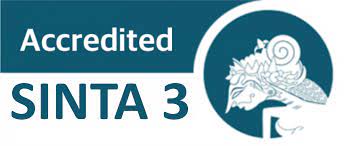Computer Mediated Communication, The Way for Developing Students’ Arabic Writing Ability
Abstract
Computer Mediated Communication, better known as CMC, can be used as a tool in improving students' Arabic writing skills. CMC is used because computers and networks are familiar to students now. CMC can also make learning to write Arabic more creative and innovative. The purpose of writing this article is to provide information about computer-mediated communication (CMC) and also how to apply CMC to learning to write Arabic, to improve student writing skills.
يمكن استخدام التواصل عبر الكمبيوتر ، المعروف باسم CMC ، كأداة لتحسين مهارات الطلاب في الكتابة باللغة العربية. يتم استخدام CMC لأن أجهزة الكمبيوتر والشبكات مألوفة لدى الطلاب الآن. يمكن أن تجعل CMC تعلم الكتابة العربية أكثر إبداعًا وابتكارًا. الغرض من كتابة هذه المقالة هو توفير معلومات حول التواصل عبر الكمبيوتر (CMC) وأيضًا كيفية تطبيق CMC على تعلم الكتابة باللغة العربية ، لتحسين مهارات كتابة الطلاب.
Keywords
Full Text:
PDFReferences
Baron, N. S. (t.t.). Computer Mediated Communication as a Force in Language Change, 24.
Cummings, M. C. (t.t.). “Because We Are Shy and Fear Mistaking”: Computer Mediated Communication with EFL Writers, 26.
Everett, D. R., & Ahern, T. C. (1994). Computer-Mediated Communication as a Teaching Tool: A Case Study. Journal of Research on Computing in Education, 26(3), 336–357. https://doi.org/10.1080/08886504.1994.10782095
Hosseini, S. B. (2015). COMPUTER-MEDIATED COMMUNICATION: PEDAGOGICAL AND LANGUAGE LEARNING IMPLICATIONS, 6(1), 14.
McComb, M. (1994). Benefits of computer‐mediated communication in college courses. Communication Education, 43:2, 159–170. https://doi.org/10.1080/03634529409378973
Mohamed, M., & Zouaoui, M. (2014). EFL Writing Hindrances and Challenges: The case of Second Year Students of English at Djillali Liabes. Journal of Educational and Social Research. https://doi.org/10.5901/jesr.2014.v4n3p149
Mohammad, H. M. F. (2018). EFL Learners’ Attitudes towards Cooperative Learning in the Writing Skill. International Journal of Language and Linguistics, Vol. 5, No. 4. https://doi.org/10.30845/ijll.v5n4p11
Pratiwi, F. D., & Si, M. (2014). COMPUTER MEDIATED COMMUNICATION (CMC) DALAM PERSPEKTIF KOMUNIKASI LINTAS BUDAYA (Tinjauan Pada Soompi Discussion Forum Empress Ki TaNyang Shipper), 7(1), 16.
Shin, D.-S. (t.t.). ESL Students’ Computer-Mediated Communication Practices: Context Configuration. Language Learning, 20.
Trimantara, P., & Pd, S. (2005). Metode Sugesti-Imajinasi dalam Pembelajaran Menulis dengan Media Lagu, 14.
Walther, J. B., Bunz, U., & Bazarova, N. N. (2005). The Rules of Virtual Groups. Th Hawaii International Conference on System Sciences, 10.
Xu, L., & Yi, C. (t.t.). 81. Emotional Expression Online: the Impact of Task, Relationship and Personality Perception on Emoticon Usage in Instant Messenger, 15.
Zheng, B., & Warschauer, M. (2017). Epilogue: Second language writing in the age of computer-mediated communication. Journal of Second Language Writing, 36, 61–67. https://doi.org/10.1016/j.jslw.2017.05.014
DOI: https://doi.org/10.18860/abj.v3i2.6208
Refbacks
- There are currently no refbacks.
Copyright (c) 2018 Abjadia : International Journal of Education

This work is licensed under a Creative Commons Attribution-NonCommercial 4.0 International License.
...............................................................................................................................................................
Mailing Address:
Ruang Jurnal Abjadia, Fakultas Ilmu Tarbiyah dan Keguruan (FITK)
Universitas Islam Negeri (UIN) Maulana Malik Ibrahim Malang
Jalan Gajayana 50 Malang 65144, Jawa Timur, Indonesia
Phone/Faximile: (+62341) 552398, Phonsel: +6281333666063
Website: http://ejournal.uin-malang.ac.id/index.php/abjadia
Email: abjadia@uin-malang.com
Abjadia: International Journal of Education. This work is licensed under a Creative Commons Attribution-ShareAlike 4.0 International License.
...............................................................................................................................................................
Indexed by:






